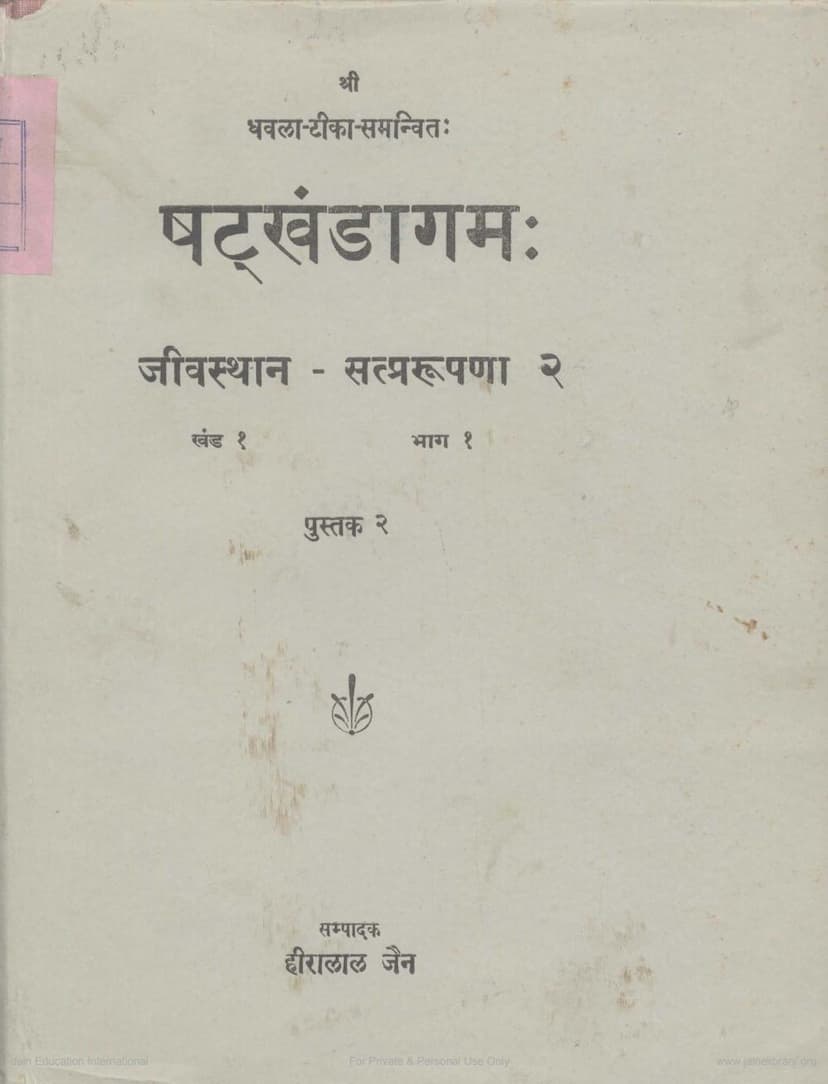Shatkhandagama Pustak 02
Added to library: September 2, 2025

Summary
This is a summary of Book 2 of the Shatkhandagama, titled "Satprarupana," compiled by Pushpadanta and Bhutabali, with commentary by Virasena. The book was published by the Jain Sahityoddharak Fund Karyalay in Amravati in 1940 AD (V.S. 1997, V.N. 2466).
The book is a Hindi translation and commentary of the Satprarupana section of the Shatkhandagama, a foundational text in Digambara Jain philosophy. It is part of a larger project to publish the entire Shatkhandagama with comprehensive explanations and translations.
Key elements of the book and its content:
- Authorship and Commentary: The original work is attributed to Acharyas Pushpadanta and Bhutabali, while the extensive commentary, known as Dhavala, is by Acharya Virasena. This volume is edited by Hiralal Jain and assisted by Pandit Phoolchandra and Pandit Hiralal Shastris, with support from Pandit Devakinandan and Dr. A. N. Upadhye.
- Content Focus: This volume focuses on the "Satprarupana" (also referred to as "Jivasthana - Satmarupana 2"). It delves into the detailed classification and analysis of soul qualities (Jivas) across various stages of spiritual advancement and existence.
- Structure: The book is structured with:
- Prastavana (Introduction): Discusses various aspects, including the age of the Mudbidri palm-leaf manuscript of Dhavala, the inclusion of the Vargana Khanda, the authorship of the Namokara Mantra, a comparative review of the contents of Ditthivada (the twelfth Srutanga), and the subject matter, language, and style of the work.
- Shuddhipatra (Errata): Lists corrections for the first volume.
- Shatkhandagama Prastavana (Introduction to the Shatkhandagama): Provides detailed historical and textual context, including the dating of manuscripts, controversies about the inclusion of certain sections, and the lineage of Jain scholars.
- Satprarupana Section: This is the core of the volume, containing the original Prakrit text, Hindi translation, and extensive commentary. It is divided into various sections (Alap) and sub-sections, systematically analyzing different categories of soul qualities.
- Vargana Khanda Vichar (Discussion on Vargana Khanda): Addresses the question of whether the Vargana Khanda was part of the Dhavala text.
- Namokara Mantra ke Adikarta (Authorship of the Namokara Mantra): Discusses the origin and authorship of the most sacred Jain mantra.
- Barahven Srutanga Ditthivada ka Parichay (Introduction to the Twelfth Srutanga, Ditthivada): Provides a detailed overview of the lost twelfth Anga of the Jain canon.
- Subject Matter, Language, and Style: Explains the scope of the text, its Prakrit language, and the analytical style, often featuring enumerations and numerical specifications.
- Tables of Contents and Indexes: Extensive tables of contents and special subject matter indexes (Alap Suchi) are provided to facilitate easy reference and understanding of the complex classifications.
- Editorial Approach: The editors emphasize their commitment to accurately presenting the original text and providing clear Hindi translations and explanations. They acknowledge the difficulties encountered in deciphering and reconstructing the ancient texts and express gratitude for the cooperation of scholars and institutions.
- Key Concepts: The text meticulously analyzes:
- Gunathana (Stages of Spiritual Progress): The 14 stages of spiritual development are a central framework.
- Jivasama (Types of Souls): Classification of souls based on senses, activities, and other characteristics.
- Paryapti (Fulfillment): The process by which souls attain the necessary physical and mental faculties.
- Prana (Life-Forces): The 10 vital forces that sustain life.
- Samjna (Consciousness/Perception): The four types of consciousness.
- Gati (Realms of Existence): The four states of birth (hellish, Tiryancha, human, heavenly).
- Indriya (Senses): The five senses and their implications.
- Kaya (Bodies): The different types of bodies.
- Yoga (Activities): The activities of mind, speech, and body.
- Veda (Sex/Temperament): The three types of sexual energies.
- Kashaya (Passions): The four types of negative emotions.
- Jnana (Knowledge): The five types of knowledge and their limitations.
- Samya (Control): The different levels of control over passions and senses.
- Darshana (Perception): The types of perception.
- Leshya (Disposition/Coloration): The six types of karmic dispositions.
- Scope of Analysis: The text systematically examines these categories in relation to different states of existence (gatis), stages of spiritual progress (gunasthanas), and other vital classifications. The detailed tables of contents indicate a vast number of such analyses (alapas).
In essence, Book 2 of the Shatkhandagama, "Satprarupana," is a profound and detailed treatise on Jain ontology and psychology, aiming to provide a comprehensive understanding of the soul's journey and its various states and qualities through meticulous classification and analysis. The volume represents a significant effort in preserving and making accessible a crucial text of Jain philosophy.